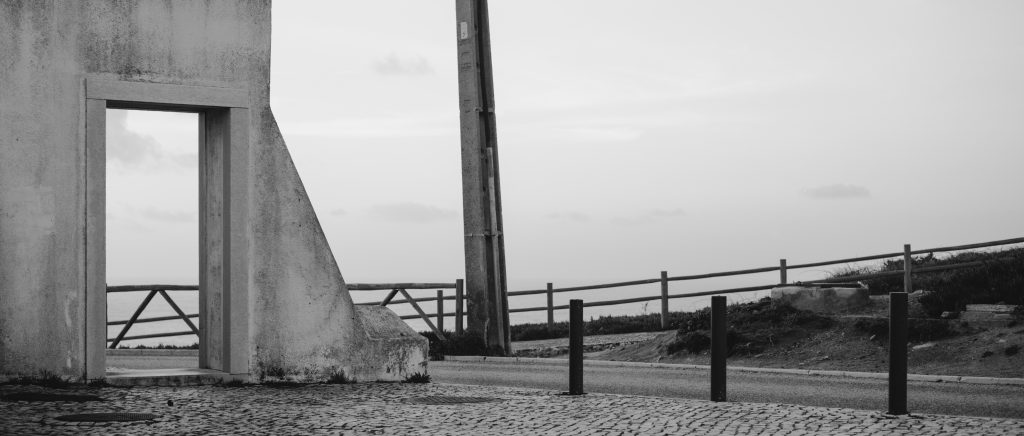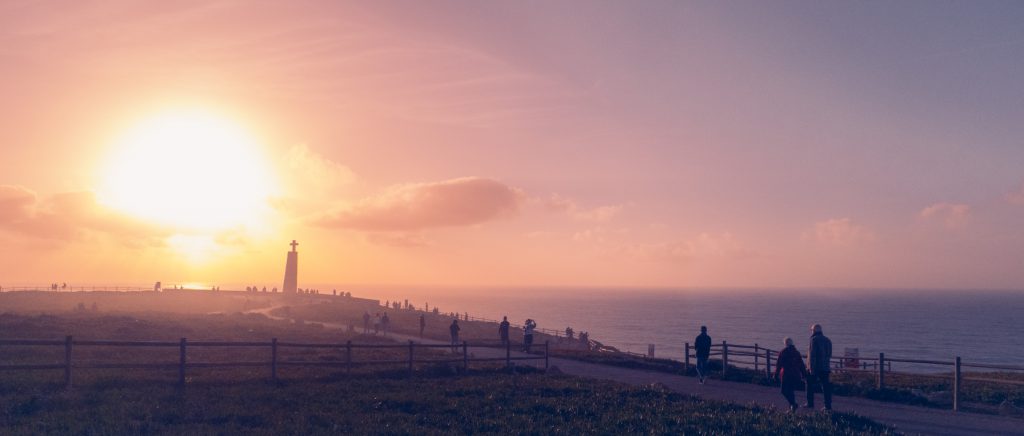Cabo da Roca is a cape which forms the westernmost extent of mainland Portugal, continental Europe and the Eurasian land mass. The cape is in the Portuguese municipality of Sintra, near Azóia, in the southwest of the district of Lisbon, forming the westernmost extent of the Serra de Sintra. Cabo da Roca was known to the Romans as Promontorium Magnum[1] and during the Age of Sail as the Rock of Lisbon. The western coast is a mixture of sand beaches and rocky cliff promontories: around Cabo da Roca, cliffs are more than 100 metres in height, and cut into crystalline rocks, composed of strongly folded and faulted sedimentary units. These forms are disturbed by dikes and small beache.
Cabo da Roca ist der westlichste Punkt des Festlands des europäischen Kontinents. Er liegt in Portugal an der Atlantikküste westlich von Lissabon in einer Höhe von 140 Metern über dem Meeresspiegel. Cabo da Roca gehört zur Gemeinde (freguesia) Colares im Kreis (concelho bzw. municipio) Sintra. Die Hänge sind invasionsartig mit der Essbaren Mittagsblume (Carpobrotus edulis) bewachsen. Diese wird dort als „gefährlicher Eindringling“ ausgewiesen. In den Felswänden nisten seltene Wanderfalken (Falco peregrinus) und Turmfalken (Falco tinnunculus). Der portugiesische Nationaldichter Luís de Camões hat den Ort mit folgenden Worten beschrieben: Hier… Wo die Erde endet und das Meer beginnt… (Aqui… onde a terra se acaba e o mar começa).
罗卡角(葡萄牙语:Cabo da Roca)是葡萄牙境内一个毗邻大西洋的海岬,是整个欧亚大陆的最西南点。罗卡角位于北纬38度47分,西经9度30分,距离里斯本大约40公里。人们在罗卡角140米高的山崖上建了一座灯塔和一个面向大洋的十字架。碑上以葡萄牙语写有著名的一句话:“陆止于此、海始于斯”(葡萄牙语:Aqui… onde a terra se acaba e o mar começa)。 “每个到葡萄牙游览的客人,罗卡角是必然的选择,这里是欧洲的‘天涯海角’,是远航的水手们对陆地的最后记忆。”纪录片《大国崛起》如此描述罗卡角,这个毗邻大西洋的葡萄牙海岬。地处葡萄牙首都里斯本以西,罗卡角为葡萄牙最西端,亦是欧洲大陆的最西点。这一地理坐标使罗卡角充满了纪念意义,令人一心向往。世界和海洋非常宽广,宽广到会让你经历过才明白,一切梦想到头来都很笨;宽广到让你明白,梦想并不会因为脆弱、渺小与笨,就失去其兑现的价值。最后,等你哪一天重新想起荒诞远大甜蜜愚昧可笑灿烂的梦想,等你相信某个梦想再怎么笨都值得兑现,那就是了。

Monument declaring Cabo da Roca as the westernmost extent of continental Europe 
The Lighthouse on the top of cliffs 
The Atlantic Ocean 
The Atlantic Ocean 
The granite boulders and sea cliffs along the coast 
The Carpobrotus edulis spread onto the plateau of the Cape 
Old building near the coast of Cabo da Roca
来吧!到罗卡角来,告诉大西洋你所有的情绪,然后,转身离去,像葡萄牙航海家们一样去战斗。沿曲折的公路一路向上便可抵达这个欧洲大陆的尽头。罗卡角上伫立着一座高大的十字架纪念碑,碑上镌刻着罗卡角的经度、纬度和高度,时刻提醒着这里所占据的特殊地理位置。碑体的上端刻有一句响亮的诗句:陆止于此、海始于斯(Aqui, onde a terra se acaba e o mar começa),它出自葡萄牙最伟大诗人路易•卡蒙斯(Luís de Camões)描写葡萄牙航海家开辟新海路的史诗《葡国魂》。与之呼应的是不远处一块刻有航海轮舵形状的地质标志石,而更远处,一座灯塔威严屹立,指引迷途的人们回家。纪念碑、标志石与灯塔共同站立在这个世界角落之上,面向无垠的大西洋,静观世间的沧海桑田。顺着小道往前,步行至悬崖栅栏前,视野里是那无尽的、永远翻滚着的蓝色海洋,海浪涌向岸边岩石的拍打声间歇传来,海风时而温柔时而呼啸而来。一低头,便可望见那陡峭的崖壁;沿着山崖小道小心走一个来回,就在这天涯海角,与大西洋来一次亲密接触。如果时间凑巧,再与心爱之人依偎而坐,等待那轮落日缓缓坠进海洋之中。
